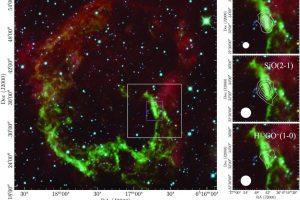Supernova explosions can trigger star formation events. The study: “Negative and positive feedback from a supernova remnant with SHREC: a detailed study of the shocked gas in IC443” of G. Cosentino (Chalmers University of Technology) recently appeared on MNRAS

A supernova is the final act of the evolution of a massive star. These spectacular explosions are among the most energetic events we observe in the Universe, and they can seriously impact the surrounding environment. In particular, during the expansions of the supernova remnants, which are the expanding clouds produced by supernova explosions, the process of star formation in the surrounding clouds can be seriously impacted. In fact, the clouds can be wiped out by the incidence of the expanding remnants, halting the process of star formation (negative feedback), or they can be compressed, facilitating their gravitational collapse and triggering new star formation (positive feedback).
In the past years, several theoretical models have been developed with the attempt of studying this interaction and understanding the conditions that lead to a positive or to a negative feedback. This is a difficult task, since these models must account for the complex physics regulating the interaction between the cloud and the supernova remnants which is adiabatically expanding (which means that the energy loss due to radiation are negligible). Important information can also be obtained with observations of the radio emission probing the presence of shocked gas at high density. A typical example is the emission due to silicon monoxide (SiO), which probes gas at density in excess of 105 cm-3, which is not observed in quiescent clouds.
This is the objective of the survey “SHock interactions between supernova REmnants and molecular Clouds” (SHREC), which is based on observations of the 12-meters antenna of the Arizona Radio Observatory. In the framework of this survey, also the supernova remnant IC443 has been observed. This remnant is expanding into surrounding clouds in the north-east, north-west, and south-east. The team led by the astronomer G. Cosentino (Chalmers University of Technology) analyzed the observations of IC443 obtained in the framework of the SHREC survey and with the 40-meters antenna of the Yebes Observatory. These observations allowed to find SiO emission which coincides with a front of compressed gas, clearly visible in infrared. This gas has a mass of 100 Solar masses, and its content of momentum and energy can not be explained only by ongoing star formation. Besides, its density must exceed 105 cm-3, which is more than 10 times higher than the density of the surrounding uncompressed gas, and it is consistent with the densities required by the process of star formation. The study, described in the paper: “Negative and positive feedback from a supernova remnant with SHREC: a detailed study of the shocked gas in IC443“, recently appeared on the journal The Monthly Notices of the Royal Astronomical Society, thus demonstrates that the incidence of IC443 on the surrounding clouds is triggering events of star formation. Among the coauthors of the study, there are the astronomers M. Miceli and G. Peres of the University of Palermo, and S. Orlando, S. Ustamujic, E. Greco and F. Bocchino of INAF – Astronomical Observatory of Palermo.
The figure (click here to zoom in) shows an infrared image of IC443, with marked in red the emission at 22 μm, green at 4.6 μm, and blue at 3.4 μm, obtained in the framework of the WISE all-Sky Survey. The white and magenta rectangles delimit the field observed in the framework of SHREC project and by Yebes Observatory. The right panels show the emission of SiO and H13CO+ in white contours. The emission in these bands coincides with the compressed filaments clearly visibile in infrared.
Mario Giuseppe Guarcello ( follow mguarce) ( youtube)
Follow the Astronomical Observatory of Palermo on Facebok
Subscribe the Youtube channel of the Astronomical Observatory of Palermo
